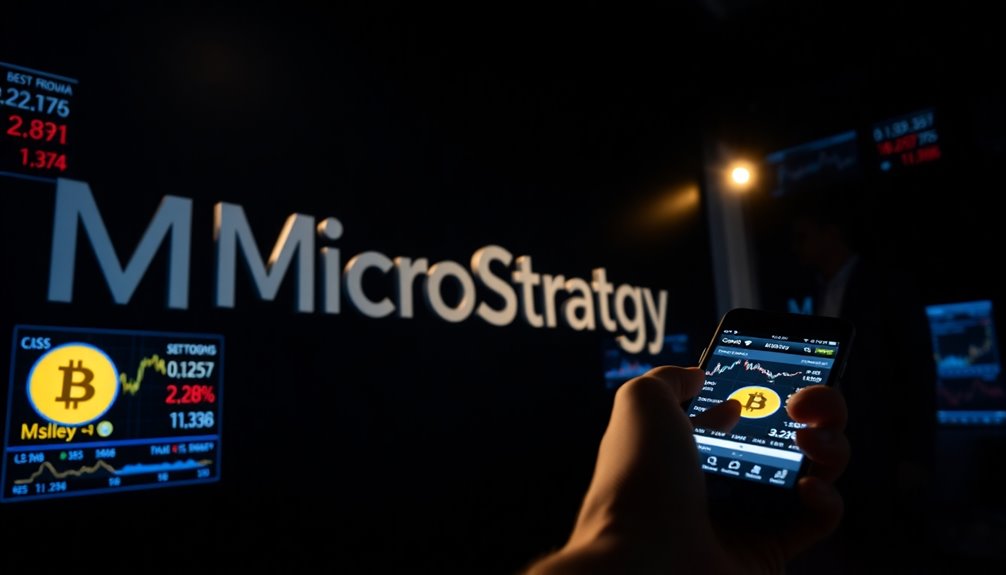MicroStrategy's Bitcoin gamble is riskier than ever, according to Anthony Pompliano. They're aggressively accumulating Bitcoin, intending to possess 4% of the total supply by 2033. This strategy relies heavily on the volatile crypto market and potential regulatory changes that could strain their financial health. With price swings and compliance hurdles increasing, the company's plan to maintain a consistent yield faces real challenges. If Bitcoin prices tumble, they may face liquidity issues from maturing debt. Stick around to discover how these factors might impact MicroStrategy's future and what it means for investors.
Key Takeaways
- MicroStrategy's aggressive Bitcoin acquisition strategy exposes it to heightened market volatility and regulatory risks, leading to potential financial instability.
- Anthony Pompliano highlights concerns over the sustainability of Bitcoin yields amid fluctuating prices and increased scrutiny from regulators.
- The company's goal to own 4% of Bitcoin supply by 2033 raises worries about liquidity risks if market conditions deteriorate.
- MicroStrategy's reliance on convertible debt for funding may create pressure if Bitcoin prices decline, impacting shareholder equity and overall financial health.
- Market sentiment, driven by political and regulatory factors, could exacerbate risks, making MicroStrategy's Bitcoin gamble increasingly precarious.
MicroStrategy's Bitcoin Acquisition Strategy

MicroStrategy's Bitcoin acquisition strategy is all about leveraging available resources to expand its crypto holdings. The company mainly uses business cash flow and stock sales to fund its Bitcoin purchases. You'll notice that MicroStrategy also borrows money through convertible loans to finance these acquisitions. Recently, they made headlines with a massive $5.4 billion purchase of 55,500 BTC, marking their largest buy to date.
Currently, MicroStrategy holds an impressive 386,700 BTC, valued at around $38 billion. They aim to own 4% of the total Bitcoin supply by 2033, which could equate to about 830,000 BTC worth $830 billion if Bitcoin hits $1 million per coin. To achieve this ambitious goal, the company is ahead of schedule in raising $42 billion over the next three years for more Bitcoin. This strategy has led to significant market value increases, as MicroStrategy's valuation is now closely tied to Bitcoin prices rather than software revenues.
Financial Logic Behind the Gamble

MicroStrategy's financial strategy hinges on its convertible debt approach, allowing you to convert debt into equity when advantageous. By utilizing premium equity sales, the company strengthens its balance sheet while minimizing risk exposure. This dynamic creates a compelling Bitcoin yield that helps you navigate the volatile cryptocurrency market. This strategy is particularly relevant in light of the recent increased institutional investment in cryptocurrencies, further influencing market dynamics.
Convertible Debt Strategy
Utilizing a convertible debt strategy, the company can effectively raise capital while minimizing immediate costs. This approach not only provides MicroStrategy with funds for its Bitcoin purchases but also appeals to investors looking for higher returns.
Here are three key points about the convertible debt strategy:
- Lower Immediate Cost: By issuing convertible debt, MicroStrategy avoids the immediate financial burden that comes with direct equity issuance, delaying equity dilution for shareholders.
- Attractive Returns: Investors are drawn to the potential for considerable returns if MicroStrategy's valuation increases, especially since they can convert their debt into equity at a discount to future valuation. Convertible debt allows for flexibility in financing options, which can be a significant advantage for startups.
- Financial Leverage: While the strategy amplifies potential gains, it also increases financial risk. If Bitcoin's value drops considerably, the company could face severe financial difficulties.
This financial logic hinges on calculating the ROI based on the conversion price and valuation cap. However, you must consider the risks associated with market volatility and regulatory uncertainty that could impact the overall success of this gamble. Balancing potential rewards against these risks is vital as you evaluate MicroStrategy's strategy.
Premium Equity Sales
Selling shares at a premium allows companies to tap into significant capital while maintaining the voting rights of existing shareholders. This strategy enables firms to generate additional funds without diluting ownership. When MicroStrategy opts for premium equity sales, it leverages the difference between the par value and the issue price, enhancing its financial position. The funds generated from share premium accounts can be utilized for various corporate purposes, thereby reinforcing the company's financial stability. This method of financing can also provide financial success by enabling strategic investments that align with market trends.
Here's how the share premium concept works:
| Aspect | Details |
|---|---|
| Share Premium Account | Represents the difference between par value and issue price. |
| Uses of Funds | Write off equity-related expenses, issue bonus shares, or pay premiums on debentures. |
| Limitations | Cannot distribute dividends or cover losses; funds are restricted to specified uses.
Bitcoin Yield Dynamics
Bitcoin's appeal as a high-yield asset has led MicroStrategy to adopt a bold strategy aimed at capitalizing on its potential returns. With a current "BTC Yield" of 12.2% year-to-date and a market value of its Bitcoin holdings being 70% higher than the initial cost, the company is positioning itself for substantial financial growth. You should consider these key factors:
- Targeted Yield: MicroStrategy aims for a consistent 4-8% annual "BTC Yield" over the next three years.
- Revenue Growth: Subscription Services Revenues have increased by 21% year-over-year, showcasing robust cash generation.
- Market Influence: The approval of spot ETFs and an upcoming Bitcoin halving event are likely to drive further market interest.
However, it's vital to be aware of the risks involved. Bitcoin's notorious price volatility can impact yield stability, and regulatory changes could pose threats to its value. Despite these challenges, MicroStrategy's strategic management and intelligent leverage highlight its commitment to a long-term Bitcoin strategy. As Anthony Pompliano points out, understanding these dynamics is essential for maneuvering the ever-evolving cryptocurrency landscape. Furthermore, the increased connectedness of Bitcoin during stressful periods highlights its role as a diversifier in normal and stressful market conditions.
Volatility and Market Challenges

Steering through the turbulent waters of cryptocurrency investments can be intimidating, especially for a company like MicroStrategy that has heavily bet on Bitcoin. The volatility in the market poses significant risks; a sharp decline in Bitcoin's price could threaten the company's financial stability. Recent fluctuations, like the spike above $100,000 followed by a quick drop, showcase how unpredictable this asset can be. Analysts predict potential for future growth if market conditions stabilize, but the immediate challenges remain daunting.
Here's a quick overview of the volatility and challenges MicroStrategy faces:
| Volatility Risks | Market Challenges |
|---|---|
| Bitcoin price fluctuations | Profit-taking and sell-offs |
| Forced liquidation risk | Short-term support and resistance |
| High leverage and debt | Changes in investor sentiment |
| Timing risks with bonds | Long-term trend uncertainty |
MicroStrategy's reliance on Bitcoin creates a tightrope walk; they must navigate profit-taking and potential sell-offs. While Bitcoin shows long-term growth, short-term dips can impact their holdings. Additionally, with high leverage, any downturn can push the company into a corner, forcing decisions that might harm their investments. The path ahead is fraught with challenges that require careful consideration and strategy.
Regulatory Uncertainties Ahead

Steering through the unpredictable landscape of cryptocurrency isn't just about market volatility; regulatory uncertainties pose another layer of complexity for MicroStrategy. As U.S. and EU agencies ramp up scrutiny, the company faces potential shifts that could greatly impact its strategy. Here are three key regulatory challenges to watch:
- Increased Compliance Requirements: New regulations could force MicroStrategy to adapt its Bitcoin acquisition strategy, impacting how it manages its holdings and financial reporting. The company's 21/21 plan aims to raise significant funds for future Bitcoin purchases, highlighting the need for clear regulatory guidance.
- Impact on Market Value: Should government scrutiny intensify or new rules emerge, you might see a sharp decline in MicroStrategy's market value, heavily tied to its Bitcoin assets.
- Tax Implications: Changes in tax laws for cryptocurrency transactions could affect the attractiveness of MicroStrategy's strategy, complicating its financial structure and appeal to investors.
These uncertainties make it important for you, as an investor or stakeholder, to stay informed about evolving regulations. The landscape is shifting, and MicroStrategy's future could hinge on how well it navigates these regulatory waters.
Risks of Premium Contraction

The risks of premium contraction present a significant challenge for MicroStrategy as it maneuvers the volatile cryptocurrency landscape. When Bitcoin's price fluctuates, it amplifies volatility within MicroStrategy's business model, leading to stagnated or decreased profit growth. You might notice that prolonged periods of price consolidation can erode market confidence, which directly impacts MicroStrategy's ability to secure financing and meet profit expectations.
During these times, the positive premium on MicroStrategy's stock can quickly converge, undermining its financing model. To counteract this, selling Bitcoin to buy back shares might become necessary, increasing market selling pressure. This cycle can create a negative feedback loop, further impacting stock performance. Furthermore, the company's reliance on BTC price volatility can create systemic risks that complicate its financial dynamics.
Additionally, monitoring premium indices is essential. A positive premium index often signals bearish trends, while a negative index can indicate bullish sentiment. Understanding these signals, along with funding rates, helps you gauge market sentiment and potential price movements. Be wary of low liquidity in crypto markets, as it can exacerbate volatility and complicate your investment strategies. As MicroStrategy faces these risks, staying informed and adaptable is key to maneuvering the turbulent waters of cryptocurrency investment.
Preparing for Extreme Scenarios

Steering through the risks of premium contraction isn't just about managing everyday volatility; it's also about preparing for extreme scenarios that could dramatically impact MicroStrategy's operations. As you consider the stakes, keep these three potential crises in mind:
- Regulatory Changes: Sudden shifts in regulations could classify MicroStrategy as an investment company, complicating its business model and strategies. You'll need to monitor the political landscape closely since election outcomes can exacerbate these risks. The Crypto Fear & Greed Index can help gauge market sentiment during such regulatory changes.
- Debt Maturity Challenges: With a significant portion of convertible bonds maturing in 2028, you face the risk of needing cash if Bitcoin prices drop. A bear market could force you to scramble for liquidity, even as you avoid force-liquidating BTC.
- Market Volatility: While Bitcoin's recent stability might seem reassuring, be prepared for volatility spikes. Historical patterns of extreme fear or greed can lead to sudden price drops, putting your financial health and BTC Yield at risk.
Frequently Asked Questions
How Does Microstrategy's Strategy Impact Its Employees and Workplace Culture?
MicroStrategy's strategy impacts its employees like a roller coaster ride—thrilling but unpredictable. You might feel motivated by the innovative culture and the potential for financial gains, yet the volatility can create anxiety about job security. If Bitcoin prices drop, your workplace morale could wane, leaving you uncertain about your future. However, the unique focus on cryptocurrency also opens specialized career paths that could enhance your professional reputation in a rapidly evolving field.
What Are the Potential Tax Implications for Microstrategy's Bitcoin Holdings?
When considering the potential tax implications for Bitcoin holdings, you need to recognize that the IRS treats Bitcoin as property. This means any gains or losses from transactions will fall under capital gains tax rules. If you sell Bitcoin after holding it for a year or less, you'll face short-term capital gains taxed at ordinary income rates. On the flip side, long-term holdings could benefit from lower tax rates, depending on your income level.
How Does Microstrategy Communicate Its Strategy to Investors?
Like a well-tuned orchestra, MicroStrategy harmonizes its communication strategy with investors. You'll receive regular email updates that keep you informed on company news and financial health. Quarterly updates and live Q&A sessions create a direct line for feedback. Annual one-on-ones foster deeper relationships, while press highlights guarantee you're in the loop. This transparent approach not only clarifies objectives but also invites your input, making you an integral part of the journey.
What Is the Public Perception of Microstrategy's Bitcoin Strategy Among Industry Experts?
Industry experts often view MicroStrategy's Bitcoin strategy with skepticism. You'll find that many believe it's overly speculative, with significant risks tied to Bitcoin's volatility. While some admire the boldness, others warn that leveraging equity and debt for Bitcoin purchases could lead to severe financial distress. You might hear calls for caution, highlighting the fragile nature of the feedback loop created by their strategy. Overall, the perception is mixed, leaning towards cautious optimism. Proponents argue that the long-term potential of Bitcoin as a store of value could validate the approach if the cryptocurrency appreciates substantially over time. However, critics in the microstrategy bitcoin strategy analysis frequently point out the company’s exposure to macroeconomic pressures and regulatory uncertainty, which could exacerbate risks. As a result, stakeholders remain divided, closely monitoring how this high-stakes gamble unfolds in the ever-changing cryptocurrency landscape.
How Can Retail Investors Participate in Microstrategy's Bitcoin Acquisitions?
If you're curious about cashing in on MicroStrategy's Bitcoin buys, consider capturing shares of MSTR stock. By doing this, you gain indirect access to their Bitcoin bounty. You can easily open an online brokerage account to start. Alternatively, you might engage in direct Bitcoin dealings via exchanges like Cash App. Just remember, staying savvy about market shifts and risks is key to smart investing in this volatile venture!
Conclusion
MicroStrategy's gamble on Bitcoin is a double-edged sword. With over 152,000 BTC acquired, the company's exposure to crypto volatility is immense. Did you know that Bitcoin's price swings can reach over 10% in a single day? This kind of instability amplifies the risks Anthony Pompliano highlights. As regulatory uncertainties loom and premium contraction threatens, it's essential to weigh the potential rewards against these formidable challenges. In the world of crypto, fortune favors the bold, but caution is wise.










